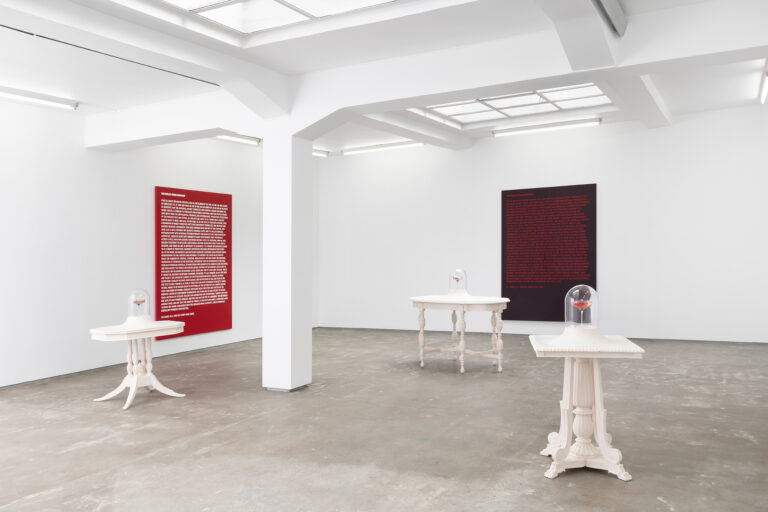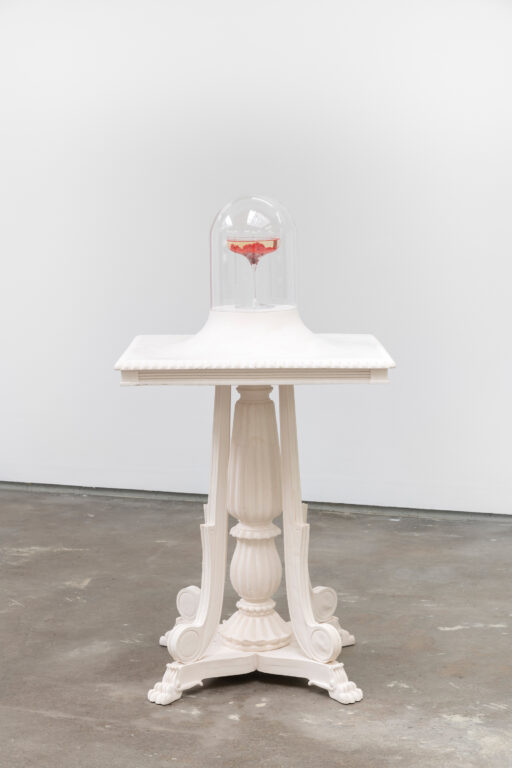Exhibition opening 25.05.2023, 18.00-20.00
In Conversation: Ane Graff & Maria Lind
MARIA LIND “Molecular dramas” describes the ongoing series of works which feature in your current exhibition at OSL contemporary, the three sculptures The Goblets (Mixed Dementia), The Goblets (Clinical Depression), and The Goblets (Panic Disorder). What is the drama and who are the actors?
ANE GRAFF The drama, or let’s say what is at stake here, lies within our bodies. As bodies we touch, ingest and inhale molecules of substances and materials we come into contact with and through these material meetings what you call a “molecular drama” takes place in our bodies, one that drives health or disease. When it comes to disease, chronic inflammation and inducers of such inflammation are an important part of the picture, as well as epigenetic changes, namely how our behaviours and environment can create changes that affect how our genes work. Following the current research in the field, I present the actors in this drama: materials from our everyday life that can be found to be correlated with specific conditions, in this case mixed dementia, clinical depression and panic disorder, within drinking glasses. These material actors can be inducers of inflammation and/or drive epigenetic changes and are part of what causes or drives disease states. I present what we would reference as our environment and its role in common diseases.
In addition to these sculptures, I will show three new paintings. Each painting presents a poetic text that speaks to each individual goblet. So there is one text about inhabiting the condition of mixed dementia, one about clinical depression and one about panic disorder. They go hand in hand with The Goblets (Mixed Dementia), The Goblets (Panic Disorder), and The Goblets (Clinical Depression).
MARIA LIND This is interesting because text often plays into your work, but in different ways. For instance, when you started with the goblets, you also introduced labels where all the components of the goblets are quoted as part of the material of the work, as part of the technique, so to speak. Can you speak about your decision to do so and what the difference is between that and your new text paintings?
ANE GRAFF All along I've written poetic texts simultaneously as I’ve been producing artworks. That's just something that's been with me always. But for a long time I didn't really know how to incorporate my personal style of writing within my sculptural practice. It took some time, but lately I have arrived at a place where the poetic texts and the sculptures create a synergy together. What the text within the paintings offer, is the story of a body afflicted with each condition, they convey bodily symptoms and speak about inflammation. Each text also dives into the subject of responsibility and accountability, namely looking for someone outside of the affected individual to hold responsible. This is an important part of the work as I find that in our society, individuals are given so much of the responsibility for their own health or disease states. This shaming of the individual or a genetic determinism or a mixture of both seems to be prevalent in our time. I would like to see the body as part of a bigger system that it cannot control and there's a society out there with politicians making decisions that affect us, such as allowing certain substances or materials that we encounter or digest or are surrounded by one way or the other into our midst.
I would say the process of incorporating text began with the captions or materials lists of the sculptures that you reference. These captions are a very, very important part of the work. Sometimes I actually say they are the work as the captions lists describes the different materials used for each goblet and, as such, is the only part that directly describe the “molecular drama” you refer to. They point directly to the intertwined narratives of the materials around us and our bodies and how we grow and change together, how a new body is built in our meeting.
MARIA LIND What do you mean by a new body is being built?
ANE GRAFF I see the body as fluid and as something that is permeable. It is part of a larger network and constantly affected, constantly marked. The background for this kind of thinking lies within feminist materialist theory, which is all about looking at matter and the matter of all bodies in a process- and relation-oriented way. Our bodies are changeable, as the field of epigenetics shows. I would say we are a work in continuous progress. The way I mix materials in the goblets to ensure that they grow and change together through powdering and crystallising them, points to this thinking of the body as a place inhabiting constant processes and relations.
MARIA LIND Let’s consider the material goblets themselves, now you are placing the glass vessels on top of cast tables. What is the material and what do you think those tables are doing in relation to the goblets?
ANE GRAFF The tables are plaster casts of seventeenth century tables. This was a choice made to place the goblets not only in our time (most of the materials picked are currently produced and available), but also to point back in time, and to the intertwined material narratives that run through time. I chose the seventeenth century more specifically as it presents a kind of thinking where the body is seen as mechanistic, divided into parts, and where the mind is separate from the body. I wanted to show what material effects, literally what “grows,” from this kind of thinking. I'm looking into the narrative of what created our circumstance today and I believe we still live and become through these kinds of ideas. One quick example if the divided subfields within the field of medicine, for example if you want to treat depression, you go to a psychiatrist and you don't necessarily look at inflammation or imbalances in the gut or imbalances in the body as a whole. The idea of separation is part of the narrative that brought us here today with the kind of material environment and disease states we currently live.
MARIA LIND Why have you selected these three goblets and what happens when you bring them together?
ANE GRAFF These are the mental conditions that most people are afflicted with. Dementia, depression, and anxiety are part of our everyday lives. No one is untouched by these. And I think how they stand there, vibrate together, says something strong about our bodies and our time.
MARIA LIND Can you give a little bit of a flavour of what goes into the depression goblet?
ANE GRAFF I like to combine different materials, some from cosmetics, others are from medications, others are foodstuffs etc. Within The Goblets (Depression) there's for example some powdered Dagens Næringsliv, a Norwegian financial newspaper from 2008, with news of the global financial crisis and the bankruptcy of the Lehman Brothers together with fruit chews, road- and tunnel dust from Oslo, mussels from Andalucía, urea fertiliser, cystic acne medication and eyeshadow. The selection of the materials is also about creating these… poems… almost, the captions lists are somehow poems of pain as the materials listed resonate together and then tell these entangled tales of our time, our bodies.
MARIA LIND I know that you spend quite some time in your studio. How do you process these things?
ANE GRAFF You might remember from visiting that the shelves of my studio are full of jars with different coloured powders and materials. I have a lot at this point, jars with small pieces of mouldy bread and dried up toothpaste or hair dye. Every material is divided into smaller parts or powdered to allow for the process of being, changing, and growing together and creating a new material through crystallisation within each individual goblet. Then each growth is sealed by a silicone polymer.
MARIA LIND Your studio looks a bit like an old-fashioned pharmacy.
ANE GRAFF That it is, but one that doesn’t hold a cure, but is potentially a driver of the disease states of our time.
Ane Graff (b. 1974, Bodø) lives and works in Oslo, Norway. She graduated from Bergen National Academy of the Arts in 2004 and currently holds a position of PhD Research Fellow at the Oslo National Academy the Arts, with her doctoral dissertation scheduled December 2022. She has been part of exhibitions such as ‘Weather Report –Forecasting Future’, Nordic Pavilion at the ‘58th Venice Biennale’, (curated by Piia Oksanen and Leevi Haapala, KIASMA), 2019; ‘Art Encounters Biennial’, (curated by Maria Lind & Anca Rujoiu), 2019; ‘Soon Enough: Art in Action’, Tensta Konsthall, Stockholm, 2018; ‘Myths of the Marble’, Henie Onstad Kunstsenter, Oslo, and the In- stitute of Contemporary Art, Philadelphia, 2017; the ‘11th Gwangju Biennale The Eighth Climate (What Does Art Do?)’, Gwangju, 2016; and ‘Surround Audience’, The New Museum Triennial, 2015, NY.
Recent exhibitions include: ‘Liquid Life’ at the Kistefos Museum (2021) curated by Martha Kirszenbaum, the Rhizome/ New Museum/ Stavanger Kunsthall collaboration ‘7x7’ (2021); and ‘2021 Liverpool Biennale’, curated by Manuela Moscoso. In 2022 Graff was the first Norwegian artist to have a solo exhibition at Kunstinstituut Melly, the Netherlands titled 'Ane Graff: The Wound in its Entanglements'.
Maria Lind (b. 1966, Stockholm) is a curator, art writer and educator. Since 2020, she has been the Counsellor of Cultural Affairs at the Embassy of Sweden in Moscow. From 2011 to 2018, Lind was Director of Tensta Konsthall, Stockholm; in 2019 she was co-curator of the third edition of the Art Encounters Biennial, Timișoara; in 2016 she was appointed artistic director for the eleventh Gwangju Bienniale, Gwangju. During the 2010's, she also held the position of Professor of Artistic Research at the Oslo Art Academy. Between 2008 and 2010 she was Director of the Graduate Program at the Center for Curatorial Studies, Bard College; from 2003 to 2005 she was the Director of IASPIS (International Artist Studio Program in Sweden), Stockholm. From 2002 to 2004 she was the Director of Kunstverein München, Munich; from 1997 to 2001 she was a curator at Moderna Museet in Stockholm; in 1998, she was co-curator of Manifesta 2, Luxembourg. In 2009, Lind received the Walter Hopps Award for Curatorial Achievement. She has been an art critic at the national dailies Svenska Dagbladet and Dagens Nyheter, in addition to writing extensively for catalogues and other publications.


